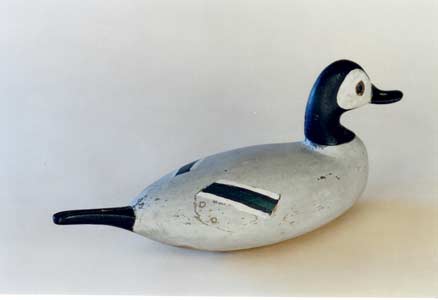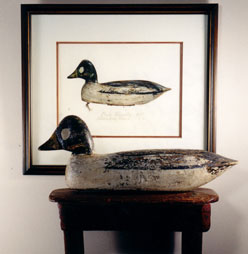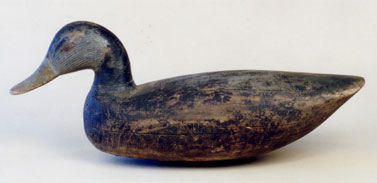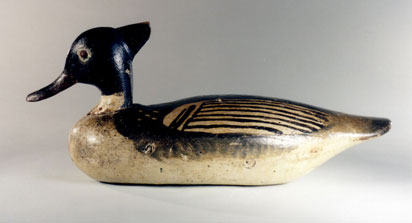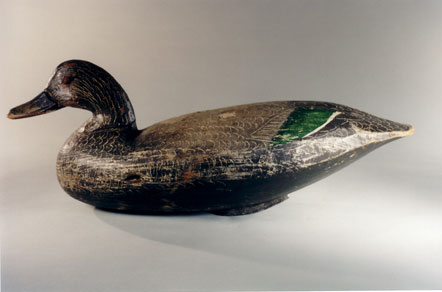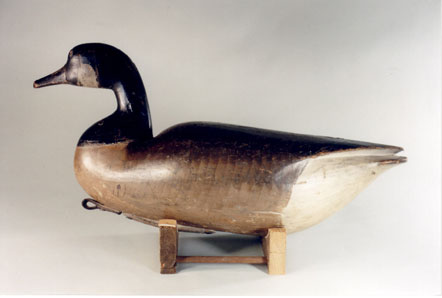|
nEWS NEWS NEWS NEWS |
|
|
|
|
|
|
|
|
by Henry Stansbury Published: Decoy Magazine September/October 2003 |
|
|
I was sitting in Jerry Hanson's Towson, Maryland basement, where he kept his stash of decoys, an area that he called his "Black Hole." It was 1981 and I was a new collector taking advice from a seasoned veteran. "Collect oddballs, Henry, they're cheap and fun," he said.
"How do you define oddballs?" I asked with a quizzical expression. He responded that I should look for "The three R's."
Realizing I hadn't a clue what he was talking about, he laughed and said, "The 3 R's, Henry - reheads, repaint, and repairs. The purists won't pay for them, so they're cheap and fun."
Jerry had a lot of oddballs in his basement, and I got a couple of them from him and quite a few others along the way. But what I found most fascinating about this collecting of oddballs is that it can have a distinct connection to the focus of your collection, if there is such a thing. I have collected decoys by Ira Hudson of Chincoteague, Virginia for years, and eventually I became interested in the repair work - the reheads, the repaints and the repairs - that he did on his decoys as well as those by other makers. Anyhow, most of the "oddball" Hudsons that I've picked up over the years have both peaked my curiosity and brought me great delight. They also illustrate another chapter in Hudson's illustrious career. |
|
|
Hudson, as far as we know, never made an oldsquaw. But I got an email attachment from Russ Goldberger some time ago informing me that he had discovered one in New England. It turned out to be a Hudson pintail that some hunter repainted to fill out his gunning rig. It's one-of-a-kind and I love it. Hudson did make goldeneyes, although any Hudson collector will tell you they’re among the rarer of his identified species. So I added a few oddballs here. The first was a Stevens brothers goldeneye from upstate New York – Hudson reheaded it then applied his paint patterns. It ended up being published in my recently released book on the Hudson family, and if a book on Stevens ever gets published, I’d like to see it included there too. The other goldeneye I bought at an auction on Long Island quite a while ago. The goldeneye had belonged to the waterfowl artist Milt Weiler, and he painted a watercolor of it years ago, which was offered in the same lot as the decoy. Weiler identified it as a Long Island decoy, and the body certainly looks like it originated there, but the head and paint are definitely Hudson. Milt liked it enough to paint it, and so do I. And I almost forgot about the pair of Hudson goldeneyes that was wonderfully repainted by Steve Ward of Crisfield, Maryland fame. |
Hudson pintail repainted by some hunter, the only oldsquaw credited to his hand

Stevens goldeneye reheaded and repainted by Hudson
Long Island goldeneye reheaded and repainted by Hudson |

Pair of Ira Hudson goldeneyes repainted by his Crisfield, Maryland contemporary, Steve Ward |
|
|
Back in the 1930s the eelgrass died on the bay and brant shooting ended when the big birds went looking for eelgrass somewhere else. I could imagine this was when a hunter brought a big brant body to Hudson and said, “Ira, put a black duck head on this body, as there aren’t any brant left around here,” or something like that. That could be the case, as the one in my collection has a body from the 1920s and a head from the 1930s, and Ira would certainly do whatever a customer wanted, as long as they were willing to pay for the service.
And there are lots of other bargain oddballs that Hudson had his hand in. There’s a Mason merganser with a Hudson head and paint job. There’s a small rig of nice early 19th century bluebills from Virginia that Hudson repaired, possibly his earliest repair work. I’ve found five so far; three have Hudson heads and all have Hudson paint. |
Hudson reheaded one of his brant decoy bodies and repainted it as a black duck
Mason decoy body reheaded and painted as a merganser by Ira Hudson |

19th century Virginia bluebills repaired by Hudson |
Speaking of paint, Charles Birch of Willis Wharf, Virginia could carve beautiful decoys, but wasn’t much of a painter. A tiny pair of his buffleheads looks fabulous in Hudson paint. Doug Jester falls into a similar category of being a better carver than painter. I have a Jester black duck painted like a pintail hen. Maybe Hudson thought that’s what it looked like, or maybe the hunter needed a pintail. We’ll never know but it’s fun to guess. |
|
Charles Birch's bufflehead pair in Hudson paint |
|
|
Most
famous of all of Hudson’s repaints are a rig of Walter Brady geese
from the Cobb Island Hunting Resort. The story behind these repaints is
that Hudson and his oldest son Norman sailed down to Cobb Island from
Chincoteague in the mid to late 1920s and repainted their rig. About a
half dozen of these graceful geese were in the mix. I picked up mine
from the collection of Harold Haertel, and it was said to be his
favorite decoy and graced the auction cover when his collection was sold
in April 1990. Of course,
this decoy didn’t quite fall into the category of “cheap and fun,”
but the rest of them did.
|
Large-bodied black duck by Doug Jester of Chincoteague repainted by Hudson as a pintail hen
Turn of the century Canada goose by Walter Brady of Northampton County, Virginia, repainted by Ira Hudson |
|
Read other articles written by Henry |
|
|
|
|


